
Jagannatha is a deity worshipped in regional Hindu traditions in India as part of a triad along with his brother Balabhadra, and sister, Subhadra. Jagannath, within Odia Hinduism, is the supreme god, Purushottama, and the Para Brahman. To most Vaishnava Hindus, particularly the Krishnaites, Jagannath is an abstract representation of Krishna, or Vishnu, sometimes as the avatar of Krishna or Vishnu. To some Shaiva and Shakta Hindus, he is a symmetry-filled tantric form of Bhairava, a fierce manifestation of Shiva associated with annihilation.
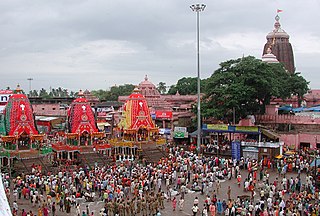
The Ratha Yatraof Puri, also rendered as the Ratha Jatra, is considered the oldest and largest Hindu chariot festival celebrated annually, on the bright half of the lunar month of Ashadh (June–July). The festival is held at the city of Puri, in the state of Odisha, India and associated with the deity Jagannath. During the festival, three deities are drawn by a multitude of devotees in three massive, wooden chariots on bada danda to Gundicha Temple whereby they reside there for a week and then return to the Jagnannath temple. This return trip is referred to as the Bahuda Yatra.

Puri is a coastal city and a municipality in the state of Odisha in eastern India. It is the district headquarters of Puri district and is situated on the Bay of Bengal, 60 kilometres (37 mi) south of the state capital of Bhubaneswar. It is also known as Sri Jagannatha Dhama after the 12th-century Jagannath Temple located in the city. It is one of the original Char Dham pilgrimage sites for Hindus.
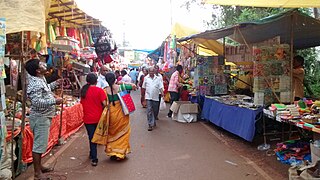
Zatra(जात्रा) is the Konkani language term for the pilgrimage festivals celebrated at Hindu temples in Goa, India; the equivalent of yatra and jatra. In Maharashtra the alternative term Urus is used as well.
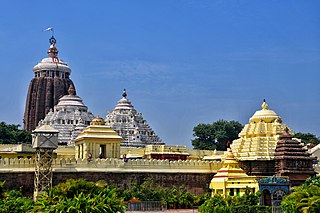
The Jagannath Temple is an important Hindu temple dedicated to Jagannath, a form of Vishnu–one of the trinity of supreme divinity in Hinduism. It is located in Puri in the state of Odisha, situated on the eastern coast of India. As per temple records, the mythical King Indradyumna of Avanti built the main temple of Jagannath at Puri. The present temple was rebuilt from the tenth century onwards, on the site of the pre-existing temples in the compound, but not the main Jagannath temple, and begun by Anantavarman Chodaganga, the first king of the Eastern Ganga dynasty. Many of the temple rituals are based on Oddiyana Tantras which are the refined versions of Mahayana Tantras as well as Shabari Tantras which are evolved from Tantric Buddhism and tribal believes respectively. The local legends link the idols with aborginal tribes and the daitapatis (servitors) claim to be descendants of the aboriginals. The temple is one of the 108 Abhimana Kshethram of the Vaishnavite tradition.

The Rathayatra of Mahesh is the oldest chariot festival in Bengal, and is said to have been celebrated since 1396. The first temple of Jagannath Deb was built by Raja Manohar Roy Of Sheoraphuli Raj who also denoted large portion of land in establishing the Jagganathpur Mouza. It is held in Mahesh, a historical locality within Serampore in the Indian state of West Bengal. It is a week-long festival and a grand fair is held at that time. People throng to have a share in pulling the long ropes (Rosshi) attached to the chariots of Lord Jagannath, Balarama and Subhadra on the journey from the temple to Mahesh Gundicha Bari and back within 8th day.

Yātrā, in Indian-origin religions, Hinduism, Buddhism, Jainism and Sikhism, generally means a pilgrimage to holy places such as confluences of sacred rivers, sacred mountains, places associated with Hindu epics such as the Mahabharata and Ramayana, and other sacred pilgrimage sites. Visiting a sacred place is believed by the pilgrim to purify the self and bring one closer to the divine. The journey itself is as important as the destination, and the hardships of travel serve as an act of devotion in themselves.
Salabega was an Odia religious poet of India in the early 17th century who wrote Jagannatha bhajanas. He was Muslim by birth but his devotion for the Hindu God made Lord Jagannath stop his Ratha Jātrā in Odisha for him to get darshan. His famous Bhajan 'Ahe Nila Saila' lives to this day.
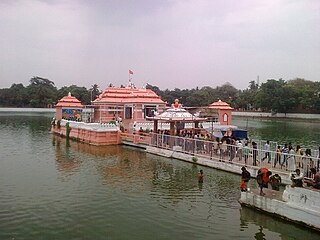
Chandana Yatra also known as Gandhalepana yatra is the longest festival observed at Jagannatha temple at Puri, India. Chandana Yatra meaning Sandalwood Voyage in Sanskrit, which continues for 42 days is observed in two parts: Bahara Chandana and Bhitara Chandana

The Snana Yatra, also spelt Snana Jatra, is a bathing festival of deities celebrated on the purnima of the Hindu month of Jyeshtha. It is the auspicious birthday of Jagannath.

Gundicha Temple, is a Hindu temple, situated in the temple town of Puri in the state of Odisha, India. It is significant for being the destination of the celebrated annual Rath Yatra of Puri. While it remains vacant most of the year, the temple is occupied by images of the deities of Jagannath, his brother Balabhadra and sister Subhadra for seven complete days every year during the annual Rath Yatra festival.

Jagannath Temple is a Hindu temple dedicated to Lord Vishnu and located in Alwar, India. The temple's presiding deity is anthropomorphic form of Lord Jagannath of Puri, while other two deities are SitaramJi, the Shaligram maharaj and JankiJi, the goddess Laxmi. The temple is built several meters above the ground in old part of the city. It has awe inspiring medieval architecture and rare floral motifs adorn its walls and pillars. The Garbhagriha has two deities of Lord Jagannath, one is movable while other is fixed. It is probably the only temple where two deities of one presiding Lord reside simultaneously. The temple is famous for its annual Rath Yatra festival where Lord Jagannath is carried in a chariot called Indra Vimana. The chariot, earlier an elephant carriage, had been used by erstwhile Maharaja of Alwar and was donated to the temple later on to be used for the Rath yatra. The Rath Yatra festival follows different traditions and rituals than those of Puri. Here, it is part of annual wedding celebration between Lord Jagannath and JankiJi at Roopbas. The fixed deity of Lord Jagannath, Budhe Jagannath, is much older and available for darshana only for five days during Rath Yatra.

Shri Shri Hari Baladev Jew Bije is a famous Hindu temple located in Baripada, Mayurbhanj district, in the state of Odisha, India. The name Jagannath is a combination of the Sanskrit words Jagat (Universe) and Nath.
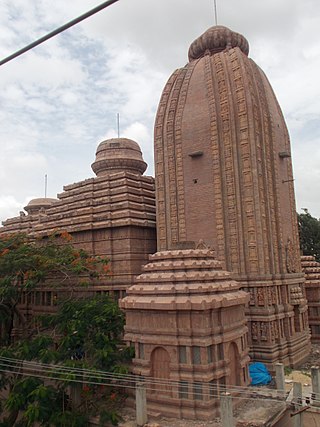
Jagannath Temple is dedicated to the Hindu god Jagannath, his brother Balabhadra, and sister Subhadra. The temple is located on Sarjapur Road in Agara in Bangalore, Karnataka, India. Its main festival is the annual Rath Yatra, which sees more than fifteen thousand devotees. The temple is maintained by the Shree Jagannath Temple Trust of Bangalore.

Ratha Yatra, or chariot festival, is any public procession in a chariot. They are held annually during festivals in India, Nepal and Sri Lanka. The term also refers to the popular annual Ratha Yatra of Puri. that involve a public procession with a chariot with deities Jagannath, Balabhadra, Subhadra and Sudarshana Chakra on a ratha, a wooden deula-shaped chariot.

The 1969 Gujarat riots involved communal violence between Hindus and Muslims during September–October 1969, in Gujarat, India. The violence was Gujarat's first major riot that involved massacre, arson, and looting on a large scale. It was the most deadly Hindu-Muslim violence since the partition of India in 1947, and remained so until the 1989 Bhagalpur violence.
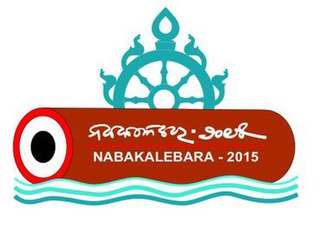
The Nabakalebara 2015 is a celebration of the ancient ritual of the Nabakalebara associated with most of the Jagannath Temples when the idols of Lord Jagannath, Balabhadra, Subhadra and Sudarshan are replaced by a new set of idols; the last such festival of events was held in 1996. The period of the festival is chosen according to the Hindu Calendar, conforming to the astrological planetary positions. The festival during 2015 involves several schedules, and it has started from 23 March with Banajaga Yatra and will conclude with Rathayatra followed Sunabesa on 27 July, with many other rituals being held in between on specific dates. More than 5 million devotees are expected to participate in these rituals held in and around the temple complex of the Jagannath Temple, Puri, Odisha.

Guptipara Rathayatra has been celebrated in Guptipara in Hooghly District of West Bengal since the 1730s. The chariot is a nabaratna-style wooden temple, where the presiding deity in the chariot is that of Brindaban Chandra jiu. The Guptipara Rathayatra is second only to the Puri Rathayatra in terms of the distance covered. One of the unique events of Guptipara Rathayatra is the bhandara loot, which is held a day before the purnayatra or the ulto rath. A month long fair is held in Guptipara on the occasion of the festival. Every year thousands of devotees take part in the festival.

Rath Yatra is a Hindu festival. In Ahmedabad Rath Yatra has been organized by Jagannath Temple, Ahmedabad on every Asadh-Sud-Bij since 1878. This annual festival celebrates Jagannath, Balrama and Subhdra.





















